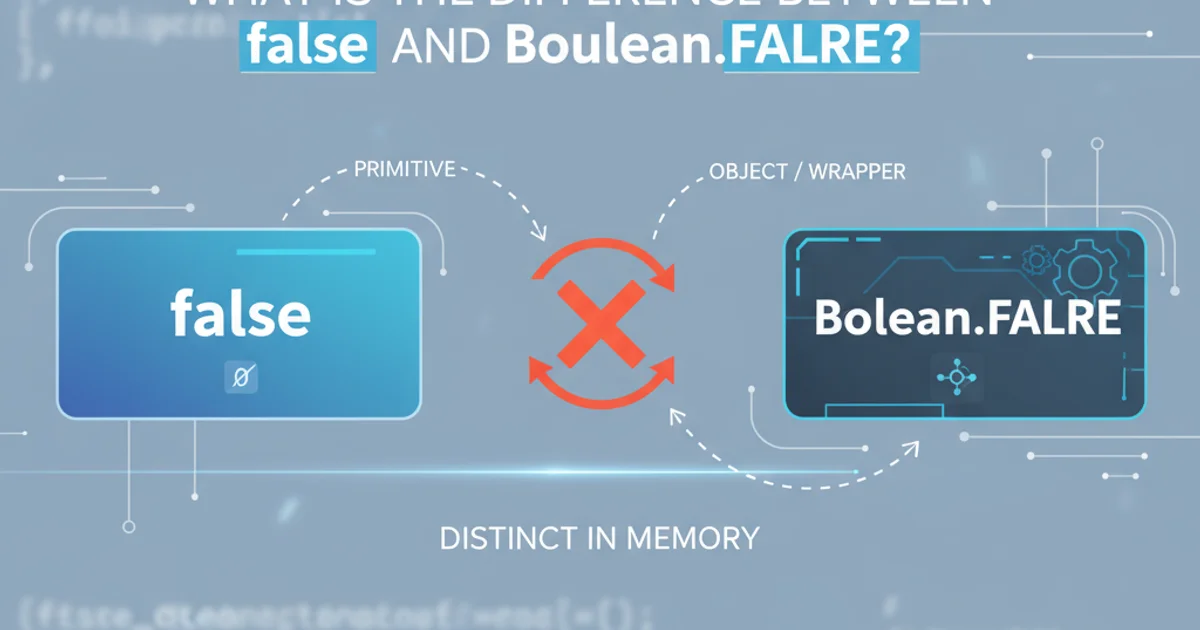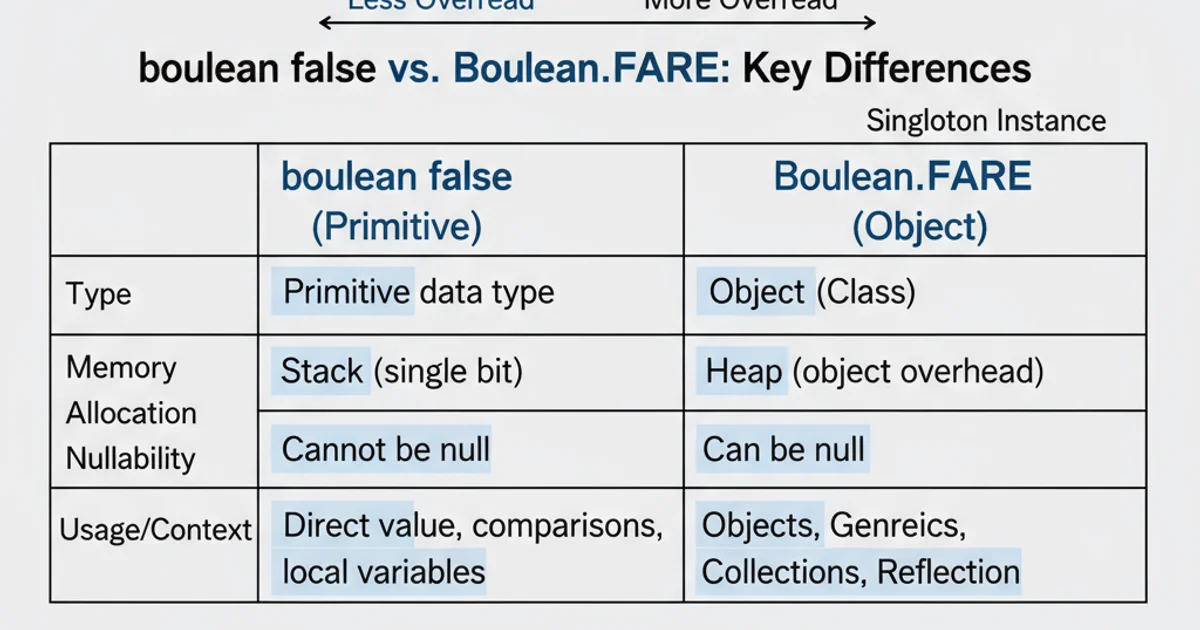What is the difference between false and Boolean.FALSE?
Categories:
Understanding false vs. Boolean.FALSE in Java

Explore the fundamental differences between the primitive boolean literal false and the Boolean wrapper object Boolean.FALSE in Java, including their memory implications, usage contexts, and performance characteristics.
In Java, the concept of truth and falsehood is central to control flow and logic. While both false and Boolean.FALSE represent the logical 'false' value, they are fundamentally different entities within the Java type system. Understanding these distinctions is crucial for writing efficient, robust, and idiomatic Java code. This article delves into their nature, usage, and the implications of choosing one over the other.
Primitive false: The Core Boolean Value
The keyword false in Java refers to the primitive boolean literal. Primitive types are not objects; they store their values directly in memory. A boolean primitive can only hold one of two values: true or false. These are the most basic and efficient representations of logical states in Java. When you declare a variable as boolean myFlag = false;, you are allocating a small piece of memory (typically 1 bit, though often stored as 1 byte for alignment) to directly hold this false value.
boolean isEnabled = false;
boolean hasError = true;
if (isEnabled) {
// This block will not execute
}
if (!hasError) {
// This block will not execute either
}
Basic usage of the primitive boolean type.
Wrapper Class Boolean.FALSE: An Object Representation
In contrast, Boolean.FALSE is a static final field of the java.lang.Boolean wrapper class. It is an object instance representing the boolean value false. The Boolean class provides an object-oriented way to handle boolean values, which is necessary when working with collections (like ArrayList<Boolean>), generics, or when a null value is a valid state (e.g., representing an unknown or uninitialized boolean). Boolean.FALSE is a pre-allocated singleton instance, meaning there's only one Boolean object representing false throughout the JVM's lifetime, which helps conserve memory compared to creating new Boolean objects repeatedly.
Boolean isActive = Boolean.FALSE;
Boolean isComplete = new Boolean(false); // Discouraged, use Boolean.FALSE or Boolean.valueOf(false)
System.out.println(isActive == Boolean.FALSE); // true (due to singleton pattern)
System.out.println(isActive.equals(Boolean.FALSE)); // true
// Autoboxing/Unboxing in action
Boolean canProceed = false; // Autoboxes primitive false to Boolean.FALSE
boolean result = canProceed; // Unboxes Boolean.FALSE to primitive false
Usage of Boolean.FALSE and autoboxing/unboxing.
flowchart TD
A[Start]
A --> B{Is it a primitive?}
B -- Yes --> C[boolean false]
B -- No --> D{Is it an object?}
D -- Yes --> E[Boolean.FALSE]
C --> F[Direct Value Storage]
E --> G[Object Reference Storage]
F --> H[Memory Efficient]
G --> I[Allows null, Generics]
H --> J[Fast Operations]
I --> K[Slightly Slower Operations]
J --> L[End]
K --> LConceptual flow illustrating the distinction between primitive false and Boolean.FALSE.
Key Differences and Implications
The primary differences between false and Boolean.FALSE stem from their fundamental nature as a primitive versus an object. These differences have implications for memory usage, performance, and how they interact with other Java features.

Comparison of false (primitive) vs. Boolean.FALSE (object).
boolean (false) when you don't need object-specific features like null or generics. It's more memory-efficient and generally faster.Autoboxing and Unboxing
Java's autoboxing and unboxing features automatically convert between primitive types and their corresponding wrapper classes. When you assign a primitive boolean to a Boolean object, it's autoboxed. When you assign a Boolean object to a primitive boolean, it's unboxed. This convenience can sometimes mask the underlying differences, but it's important to remember that these conversions involve creating or retrieving objects, which has a performance cost.
boolean pFalse = false; // Primitive
Boolean oFalse = pFalse; // Autoboxing: pFalse (primitive) -> Boolean.FALSE (object)
Boolean anotherOFalse = Boolean.FALSE; // Object
boolean anotherPFalse = anotherOFalse; // Unboxing: anotherOFalse (object) -> primitive false
System.out.println(pFalse == anotherPFalse); // true
System.out.println(oFalse == anotherOFalse); // true (due to Boolean.FALSE singleton)
Demonstration of autoboxing and unboxing with false and Boolean.FALSE.
Boolean objects using ==. While Boolean.FALSE == Boolean.FALSE is true due to the singleton pattern, new Boolean(false) == new Boolean(false) is false because they are different object instances. Always use .equals() for object comparison unless you specifically intend to check for reference equality.